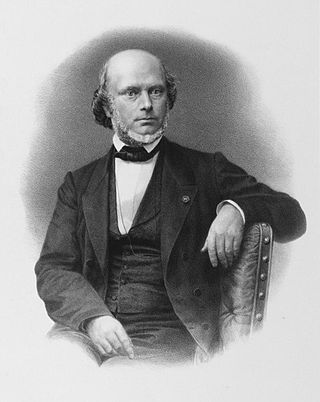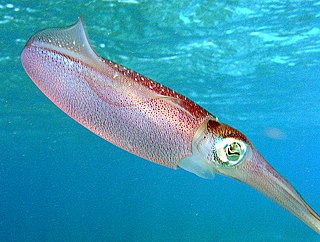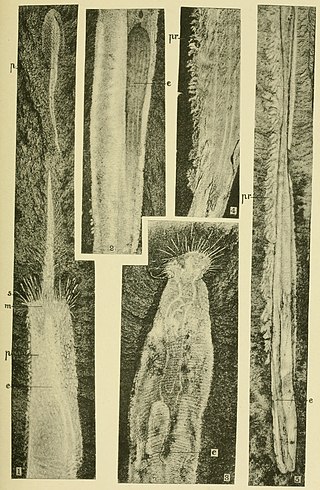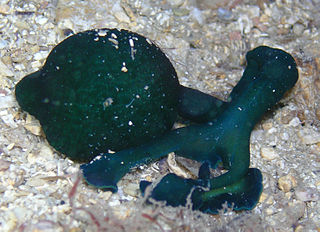Related Research Articles

The Echiura, or spoon worms, are a small group of marine animals. Once treated as a separate phylum, they are now considered to belong to Annelida. Annelids typically have their bodies divided into segments, but echiurans have secondarily lost their segmentation. The majority of echiurans live in burrows in soft sediment in shallow water, but some live in rock crevices or under boulders, and there are also deep sea forms. More than 230 species have been described. Spoon worms are cylindrical, soft-bodied animals usually possessing a non-retractable proboscis which can be rolled into a scoop-shape to feed. In some species the proboscis is ribbon-like, longer than the trunk and may have a forked tip. Spoon worms vary in size from less than a centimetre in length to more than a metre.

Nemertea is a phylum of animals also known as ribbon worms or proboscis worms, consisting of 1300 known species. Most ribbon worms are very slim, usually only a few millimeters wide, although a few have relatively short but wide bodies. Many have patterns of yellow, orange, red and green coloration. The foregut, stomach and intestine run a little below the midline of the body, the anus is at the tip of the tail, and the mouth is under the front. A little above the gut is the rhynchocoel, a cavity which mostly runs above the midline and ends a little short of the rear of the body. All species have a proboscis which lies in the rhynchocoel when inactive but everts to emerge just above the mouth to capture the animal's prey with venom. A highly extensible muscle in the back of the rhynchocoel pulls the proboscis in when an attack ends. A few species with stubby bodies filter feed and have suckers at the front and back ends, with which they attach to a host.

Polychaeta is a paraphyletic class of generally marine annelid worms, commonly called bristle worms or polychaetes. Each body segment has a pair of fleshy protrusions called parapodia that bear many bristles, called chaetae, which are made of chitin. More than 10,000 species are described in this class. Common representatives include the lugworm and the sandworm or clam worm Alitta.

Priapulida, sometimes referred to as penis worms, is a phylum of unsegmented marine worms. The name of the phylum relates to the Greek god of fertility, because their general shape and their extensible spiny introvert (eversible) proboscis may resemble the shape of a human penis. They live in the mud and in comparatively shallow waters up to 90 metres (300 ft) deep. Some species show a remarkable tolerance for hydrogen sulfide, anoxia and low salinity. Halicryptus spinulosus appears to prefer brackish shallow waters. They can be quite abundant in some areas. In an Alaskan bay as many as 85 adult individuals of Priapulus caudatus per square meter has been recorded, while the density of its larvae can be as high as 58,000 per square meter.

Jean Louis Armand de Quatrefages de Bréau was a French biologist.

Lophotrochozoa is a clade of protostome animals within the Spiralia. The taxon was established as a monophyletic group based on molecular evidence. The clade includes animals like annelids, molluscs, bryozoans, brachiopods, and platyhelminthes.

Léon Louis Vaillant was a French zoologist. He is most famous for his work in the areas of herpetology, malacology, and ichthyology.
A tubeworm is any worm-like sessile invertebrate that anchors its tail to an underwater surface and secretes around its body a mineral tube, into which it can withdraw its entire body.

Louisella is a genus of worm known from the Middle Cambrian Burgess Shale. It was originally described by Charles Walcott in 1911 as a holothurian echinoderm, and represents a senior synonym of Miskoia, which was originally described as an annelid. 48 specimens of Louisella are known from the Greater Phyllopod bed, where they comprise < 0.1% of the community. It has been stated to have palaeoscolecid-like sclerites, though this is not in fact the case.

Aspidosiphonidae is a family of peanut worms. It is the only family in the monotypic order Aspidosiphonida, which is in the class Phascolosomatidea.

Errantia is a diverse group of marine polychaete worms in the phylum Annelida. Traditionally a subclass of the paraphyletic class Polychaeta, it is currently regarded as a monophyletic group within the larger Pleistoannelida, composed of Errantia and Sedentaria. These worms are found worldwide in marine environments and brackish water.

Echiuroidea is an order of annelids in the class Polychaeta.

Ernst Heinrich Ehlers was a German zoologist born in Lüneburg.
The peristomium is the first true body segment in an annelid worm's body in the anterior end. It is directly behind the prostomium and contains the mouth, tentacular cirri, and sometimes feeding palps, which may instead occur on the prostomium. If an eversible pharynx is present, it is contained in this segment as well, and can fill up to 20 segments when inverted, depending on the species.

The annelids, also known as the segmented worms, are a large phylum, with over 22,000 extant species including ragworms, earthworms, and leeches. The species exist in and have adapted to various ecologies – some in marine environments as distinct as tidal zones and hydrothermal vents, others in fresh water, and yet others in moist terrestrial environments.

Le Règne Animal is the most famous work of the French naturalist Georges Cuvier. It sets out to describe the natural structure of the whole of the animal kingdom based on comparative anatomy, and its natural history. Cuvier divided the animals into four embranchements, namely vertebrates, molluscs, articulated animals, and zoophytes.

René-Édouard Claparède was a Swiss anatomist. The Claparède family was Protestant and originally from Languedoc. They moved to Geneva after Louis XIV:s Edict of Fontainebleau in 1685.
Pierre Louis André Fauvel was a French zoologist, who specialized in the study of polychaetes.

Fabriciidae is a family of annelid worm in the class Polychaeta.

Sedentaria is a diverse clade of annelid worms. It is traditionally treated as a subclass of the paraphyletic class Polychaeta, but it is also a monophyletic group uniting several polychaetes and the monophyletic class Clitellata. It is the sister group of Errantia.
References
- ↑ Banta, W.C.; Rice, M.E. (1970). "A restudy of the Middle Cambrian Burgess Shale fossil worm, Ottoia prolifica" (PDF). Proceedings of the International Symposium on the Biology of the Sipunculata and Echiura. 11.
- ↑ Annelida
- ↑ Armand de Quatrefages (1847). "Études sur les types inférieurs de l'embranchement des Annelés. Mémoire sur l'Échiure de Gaertner (Echiurus gaertnerii Nob.)". Annales des sciences naturelles . Series 3, Zoologie (in French). Paris: Crochard. 7: 307–343.
- ↑ Geoffrey Read (17 July 2017). "Gephyrea". WoRMS . Retrieved 7 March 2023.